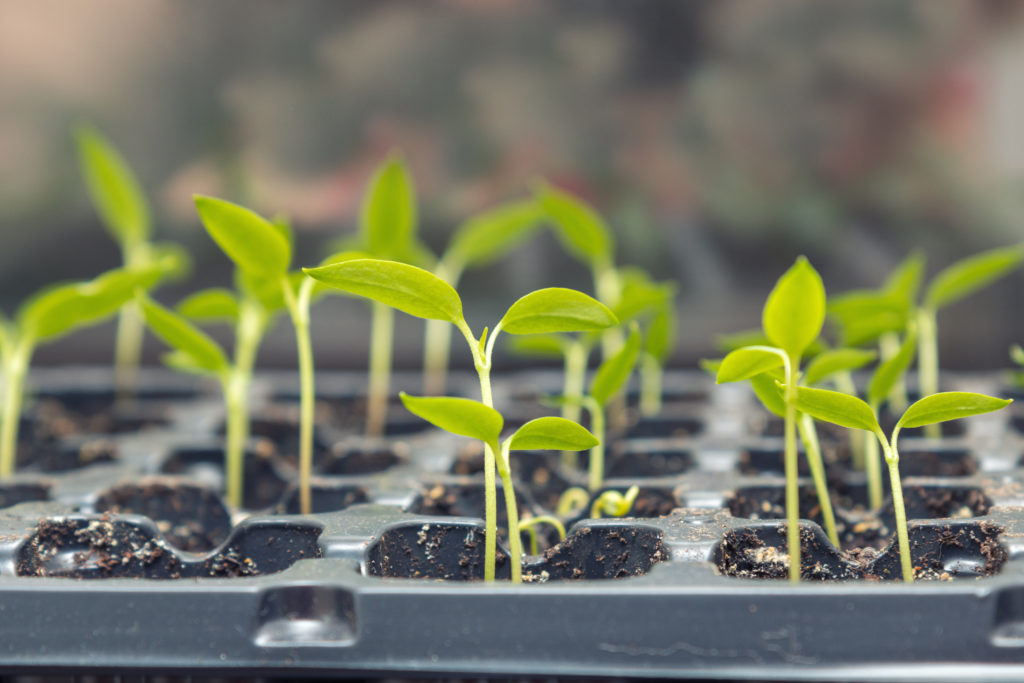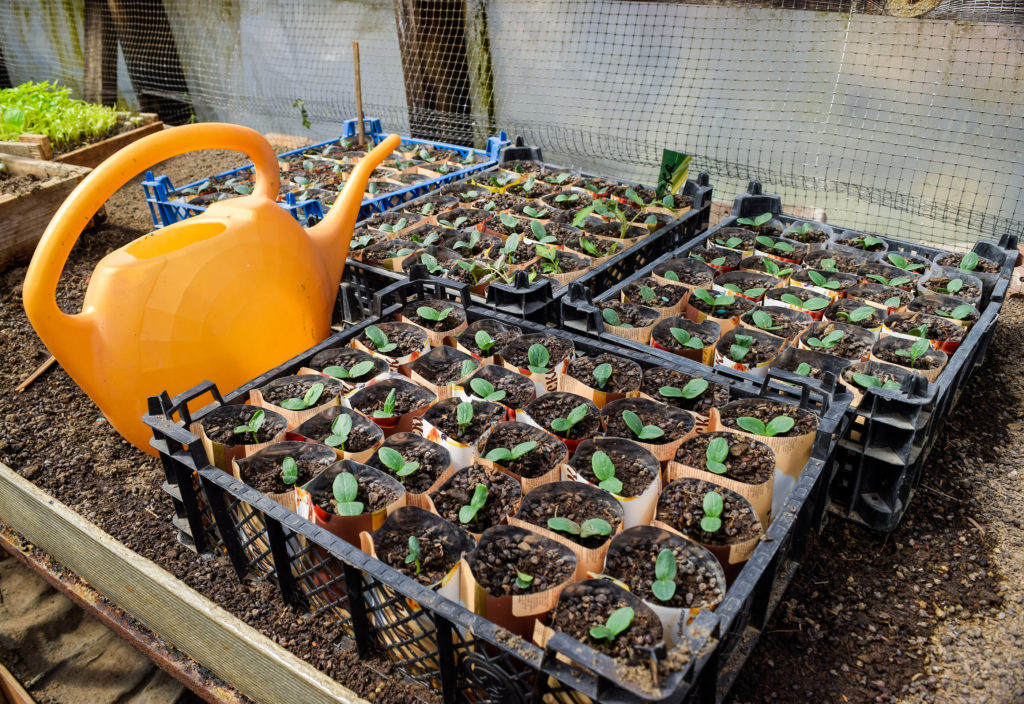Seedling heat mats provide consistent, gentle bottom heat essential to good seed germination. Heat mats are also known as seed heat mats or propagation heat mats.
Heat mats are basically two rubber mats with electric heating wires sandwiched between them. Commonly the wires of a seedling heat mat attach to a thermostat that is in turn plugged into an electrical outlet. A low-voltage current heats the wires and the rubber mats. Heat mats are usually rectangular and often about the size of one to several seed trays. Seedling heat mats are also available square sizes and in long and narrow shapes for windowsills.
Seedling heat mats are used to start plants from seeds indoors. Heat mats help replicate the natural conditions for seeds to sprout. Heat mats can also be used to encourge root growth of cuttings and to provide an optimal environment for seedling growth by maintaining a consistent soil temperature. Seedling heat mats radiate heat evenly and effectively throughout the growing medium, ensuring that seeds receive consistent warmth from bottom to top. This heat aids in stimulating root growth, enhancing germination rates, and providing a head start for seedlings.
Heat mats can also be used to maintain a stable soil temperature during colder months. This is helpful for gardeners in regions with short growing seasons or those wanting to extend their planting seasons by starting seeds early indoors. Heat mats allow plants to become established before they are transplanted outdoors.

Seedling heat mat basics to know
Seedling heat mats are designed to provide a consistent and controlled heat source for seed germination and seedling growth. Seedling heat mats work by gently warming the soil that surrounds the root zone of plants. By providing a stable temperature range, typically between 70°F and 85°F, seedling heat mats mimic the ideal conditions seeds need to sprout and establish strong root systems. The mats are made of durable materials that are resistant to water and humidity, ensuring their longevity and safety for indoor use.
Seedling heat mats do not replace other essential elements necessary for successful plant growth, such as proper lighting, watering, and nutrition. Heat mats are a complementary tool to enhance the elements necessary to promote healthy plant growth. It’s also crucial to follow the instructions provided by the manufacturer and monitor the temperature regularly to ensure optimum conditions are maintained for your plants.
Types of seedling heat mats
When it comes to starting seeds or propagating cuttings, using a seedling heat mat can greatly enhance the propagation success rate. These mats provide a consistent and gentle source of warmth to the seeds or cuttings, creating optimal conditions for germination or rooting. If you’re looking to invest in a seedling heat mat, it’s important to understand the different types available and how they can best suit your gardening needs.
Standard seedling heat mats
Standard seedling heat mats are the most common and widely used type in gardening. They are thin and flexible, resembling a flat heating pad. They are placed directly under seed trays or pots. Standard seedling heat mats usually come with a thermostat, allowing for temperature adjust to maintain the desired warmth for seeds or cuttings. Seedling heat mats are designed to withstand moisture and can be safely used in a humid or moist environment such as a greenhouse. Waterproof mats insure against water damage or electrical hazards.
Multi-zone seedling heat mats
Multi-zone seedling heat mats offer multiple heating zones. A multi-zone mat all for customized heat intensity for multiple specific plant types. A combination of tropical plants, herbs, or vegetables can be places on a seedling heat mat with multiple heating zones. Separate microclimates can be set within the same mat.
Commercial-grade seedling heat mats
Commercial-grade seedling heat mats are specifically designed to handle the demands of commercial nurseries and can accommodate a higher number of seed trays or pots. These mats can be several time the size of a strandard heating mat with multiple thermosats.

Seedling heat mat benefits
Seedling heat mats provide a controlled heating environment, which can significantly benefit plants during their early stages of growth. Here are some key benefits of using a seedling heat mat:
Accelerated germination
Seedling heat mats speed up the germination process by providing a consistent and optimal temperature range, usually between 70° and 85°F (21-29°C). This can be particularly useful for slow germinating seeds or plants that require higher temperatures to break their dormancy.
Uniform heat distribution
Unlike traditional heating methods such as placing pots near radiators or using heat lamps, seedling heat mats provide a uniform distribution of heat across the entire surface area. This ensures that each seedling receives the same level of warmth, preventing uneven growth and reducing the risk of damping-off diseases. Additionally, the warmth from the mat creates a favorable microclimate that encourages root development and helps plants achieve healthy growth.
Increased seed starting success rate
Heat mats create a consistent and stable environment for seedlings to thrive. Heat mats minimizes the chance temperature stress-induced problems and increases the chances of plant survival. The improved success rate can be particularly beneficial when starting seeds indoors or propagating delicate plants that require specific temperature conditions.
Energy efficiency
Seedling heat mats are designed to be energy-efficient. Most models incorporate low-wattage heating elements that draw minimal power to maintain the desired temperature. This means you can leave the heat mat running for extended periods without worrying about a significant increase in your electricity bill. Mats often come with thermostat controls that allow for the adjustment of temperature according to the specific plant needs. This further optimizes energy usage by ensuring that the mat only operates when necessary.
Seedling heat mat buying tips
When choosing a seedling heat mat consider the following factors:
- Choose a mat that is the right size. Measure the area where you plan to place your trays or pots. Select a mat that fits snugly within the designated space. The size of the mat should suit the number of trays or pots you plan to use.
- Choose a mat that allows you to set, adjust, and maintain the desired temperature, preventing overheating or fluctuations that can harm young plants. Different plants have varying temperature requirements for germination. Check the wattage and heating capacity of the mat to ensure it can effectively maintain the desired temperature range.
- Choose a mat with adjustable temperature settings that will allow you to meet the specific needs of different seed varieties. A mat with a built-in thermostat control provides an added layer of safety by preventing overheating, which could be detrimental to your seedlings.
- Choose a mat that is durable and water resistant. Heat mats can easily come into contact with moist soil or accidental water spills. Look for mats made of high-quality materials that are waterproof and resistant to wear and tear. A durable mat will sustain its heat output and perform consistently over time.
- Choose a mats that is UL-listed. This will ensures the mat meets necessary safety standards. Mats with built-in automatic shut-off features are also recommended, as they prevent overheating and reduce the risk of fire hazards.
- Choose a mat withe a manufacturer’s warranty, as this is an indicator of their confidence in the product’s performance and durability.
- Choose a mat that is easy to clean and maintain.
- Compare the prices and choose a mat that fits your budget. However, do not compromise quality for a lower price. It is also worth checking if
Seedling heat mat use tip
Seedling heat mat thermostats may not be accurate. It is a good idea to insert a soil thermometer into the seed flat itself to check the temperature of the flat and adjust the thermostat accordingly. Check a gardening books for ideal temperature.
See this post:

Related articles:
Choosing Plants for Containers
Flower Gardening in Containers
Container Vegetable Gardening Guide
Pot and Container Sizes for Growing Vegetable Crops
Container and Pot Sizes: How Much Soil Do I Need?
Grow Bag Vegetable Gardening Guide















